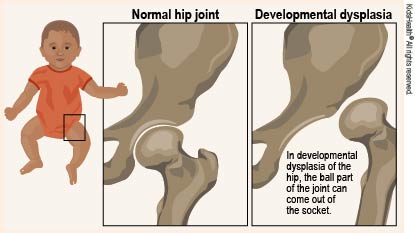Developmental Dysplasia of the Hip With a Harness: How to Care for Your Child
Developmental dysplasia of the hip (DDH) is a problem with the way a baby's hip joint forms. Sometimes the problem starts before the baby is born, and sometimes it happens after birth, as the child grows. Using the harness as instructed can help your child's hip develop normally. If the harness doesn't help, the orthopedic specialist may recommend a cast or surgery.


Bathing
-
Only remove the harness for bathing if the medical team says it's OK.
-
If your baby wears the harness 24 hours a day, don't put your baby in a bathtub. Instead, use a damp washcloth to clean your baby.
Skin care
-
Keep your baby's skin clean and dry.
-
Pay close attention to the areas where the legs meet the body and behind the knees. To keep these areas dry, wipe them with a dry cloth at each diaper change.
-
Do not use lotions, powders, or creams under the harness.
-
Change diapers often so the harness doesn't get wet or soiled.
Diaper changing
-
Lift your baby up from under the low back to remove and replace the diapers.
-
Don't lift your baby by the feet to change the diaper.
-
Make sure the straps in the back of the harness aren't caught in the diaper.
Clothing
-
Put clothing on over the harness.
-
Use one size larger, if needed.
-
One-piece outfits without a waistband work well.
-
If using a sleep sack, use one size larger to make sure the legs are free to stretch out wide.
Car seat
Keep appointments
-
While wearing the harness, your baby will need to see the orthopedic team often to check that the hips are in position and see if the harness needs an adjustment.
-
After treatment, the orthopedic team will check that the hip continues to develop normally as your baby grows.

Your baby:
-
has skin redness or rubbing from the harness
-
isn't moving the legs as much as usual
-
has a blue color in the legs
-
seems to be in pain

What causes DDH? DDH is caused by the way the hip joint is formed. The hip joint is made of a ball at the top of the thighbone (called the head of the femur) sitting in a socket (the cup-shaped bone called the acetabulum). This structure lets the hip move in lots of directions.
When a baby has DDH, the ball part of the joint may be completely, or partly, out of the socket. Sometimes the ball part may slide in and out of the socket. Often, the socket is shallow.
How long does my baby need to wear the harness? Babies usually finish wearing the harness after about 6–12 weeks. At first, your baby needs to wear the harness 23–24 hours a day. After a few weeks, your baby might wear it only at night. Follow the instructions by the medical team to make sure your baby gets the most benefit from the harness.
Can DDH run in families? Yes. The health care provider may recommend testing for DDH in any children you have in the future. If they have DDH, treatment can start right away.